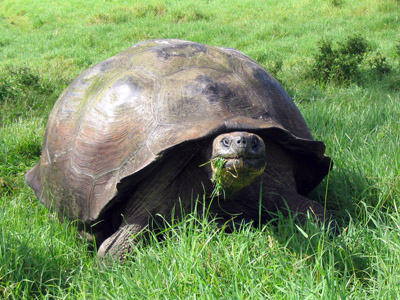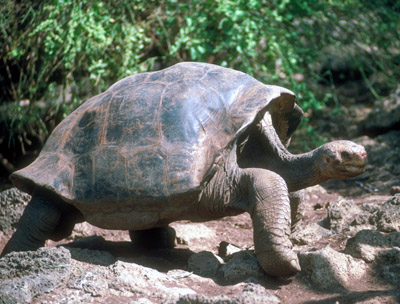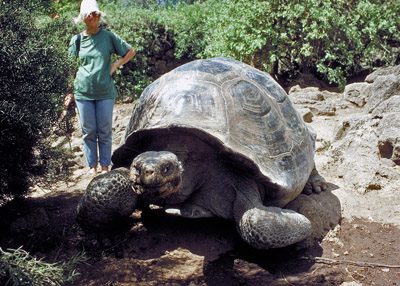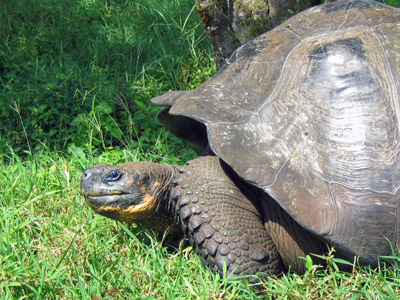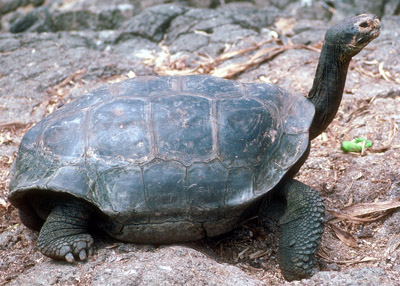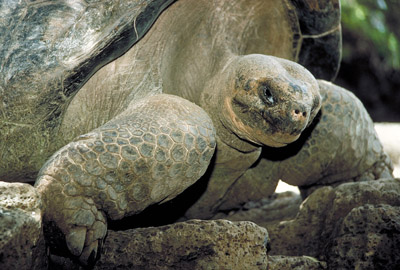Giant Tortoises are the archetypal wildlife of the Galapagos Islands. They are found only here and on the island of Aldabra 15,140 km (9,407 ml) away in the Indian Ocean. They can grow up to 417 kg (919 lb) though more commonly are around 250 kg (550 lb) at maturity.
Giant tortoises evolved on the Galapagos in the absence of competitors to fill the large herbivore niche. There are 10 surviving varieties from an original 15, different islands evolved their own variety from a common ancestor. From an estimated 250,000 in the 16th century, the total population dropped to a low of 3,000 in the 1970's though is back up to around 20,000 now as a result of conservation efforts.
Galapagos Giant Tortoises - Geochelone nigra
Profile - Animals of the Galapagos
There are two distinct groups of Galapagos giant tortoises:
Galapagos tortoise facts Basics
Weight: up to 250kg (550 lbs), though occasional larger specimens have been noted historically.
Length: up to 1.5m (4.9 feet) along the carapace (shell)
Note - "average" size is not really relevant here as giant tortoises will grow continually through their lives as long as they are well nourished, so the average size of a population depends on the average age of the population, which is currently not as old as it was in the past before giant tortoise numbers fell due to killing for food and habitat degradation. The lifespan is not known, but thought to be at least 150 years.
Breeding Season: Tortoises reach sexual maturity according to their size rather than age, it generally occurs at 20-25 years old. For the dome-shaped tortoises on the more humid islands, mating occurs in March/April at the end of the warm season, Females then dig a pit about 30cm (1 foot) deep in which they lay up to 20 leathery shelled eggs the size of a large table tennis ball, they are covered up and then left to their own devices. Hatching occurs some 120 to 140 days later.
Estimated world population: - As of 2012, there were thought to be in the region of 20,000 giant tortoises in total on the Galapagos Islands (they aren't found anywhere else).
Feeding: Herbivores consuming a wide range of edible leaves, berries, fruits, and lichens. They obtain almost all of their water from their food or from licking morning dew from leaves or rocks, they can drink large amounts of water quickly and store it, they are able to survive 6 months without water, even up to a year with no food or water due to their slow metabolism. Being cold blooded reptiles means they don't need food to maintain a warm body temperature.
Conservation status: Endangered, there are ten surviving varieties from a probable original fifteen, all are considered to be at risk. "Lonesome George" was the last representative of one of these varieties until his death in 2012 when the number of varieties dropped from eleven to ten.
Distribution: Throughout the Galapagos Islands and no-where else.
Predators: There are no predators on the adults other than man. The young tortoises, especially new hatchlings are very vulnerable to a range of native predators such as snakes, hawks, owls and herons, non-native species introduced by man such as rats, cats and dogs will also eat the young tortoises.
What are Galapagos Giant Tortoises Like?
The Giant Galapagos Tortoise is the classic Galapagos Islands animal.They gave the islands their name after the old Spanish word Galapago for "saddle" which the shape of the shell of some varieties resembles. The tortoises on the islands are all part of the same species, Geochelone nigra, sometimes called Geochelone elephantophus, they can vary considerably however and there are 15 recognised varieties. Galapagos tortoises are found nowhere else in the world other than these islands.
-
"The inhabitants... state that
they can distinguish the tortoise from different islands;
and that they differ not only in size, but in other characters.
Captain Porter has described those from Charles and from
the nearest island to it, namely Hood Island, as having
their shells in front thick and turned up like a Spanish
saddle, whilst the tortoises from James Island are rounder,
blacker, and have a better taste when cooked."
Charles Darwin - The Voyage of the Beagle
The tortoises were taken for food by passing ships in the 18th and 19th centuries. Unfortunately for them, a giant tortoise made an excellent living larder on a sailing ship far from land. they were stored upside down and would stay alive for months without water or food, this reduced the population quite significantly over the years.
There is only one other species of giant tortoise found in the world, the Aldabra tortoise which lives on islands in the Indian Ocean.
The growth rate is determined directly by the availability of food, there are rings on the individual segments of the shell (correctly called scutes) which act like the rings on a tree, years of rapid growth being wide and poor years being narrow. It is not possible to use these rings to correctly age an animal as a new and larger layer is added to the plates each year with the old one remaining above it, older layers can become rubbed off.
Galapagos Tortoises are often found with small birds - finches - around them or even perched on the shell. A special relationship has evolved between the reptiles and the birds whereby the tortoises allow the finches to eat the ticks and parasites from the tortoise's skin. The bird arrives front of the tortoise to announce its presence and the tortoise stretches out its neck and legs to expose areas where the skin is thinnest and where parasites prefer, the birds then hop about and feed themselves while relieving the tortoise of its irritations in the process.
How did the Galapagos get to have Giant Tortoises?
The Galapagos Islands are one of the few regions of the world where the predominant land animals are not mammals, but reptiles. This is thought to be a result of their isolation and the difficulty for animals of reaching them. It seems that the Galapagos have always been as isolated as they today so making the journey to them for animals long and difficult, prevailing oceanic currents are also only favourable from the South American mainland for a part of the year.
Reptiles with their greater capacity for surviving without food or water are better equipped to make this journey than mammals and the first arrivals on the Galapagos are thought to have drifted probably from South America on driftwood, or small "islands" of matted vegetation and branches that are sometimes seen being swept down rivers in flood.
When the first tortoises arrived on the Galapagos Islands, they were unchallenged by mammals and so evolved to better take over the niche of large herbivore that is taken elsewhere by sheep, goats, deer or the like. There are also a number of advantages to being large which in the absence of any natural predators on the adults, the Galapagos Tortoises could exploit in these unusual conditions unlike other tortoises almost anywhere else in the world.
Being reptiles, they are cold blooded and so regulate their temperature by behavioural means, basking in the sun to warm up and become active and by taking mud baths or by partly submerging themselves itself in water to cool down,
Tortoises can be seen in the wild on the Galapagos or at the Charles Darwin research centre on Santa Cruz (Indefatigable) Island.
Captive breeding takes place here of some of the more threatened varieties and sub-species of tortoises and land iguanas. These are then put back onto the islands where they came from to help boost the natural reproductive efforts of the wild animals. There is also a visitor centre explaining the history of the Galapagos and what conservation measures are necessary and how they are being carried out.
Top banner credit - Bernard Gagnon used under GNU1.2 license.

